The Best Text Analysis Software for Education
By Student Voice
If you are considering doing some small scale manual text analysis at your institution and don't need, for example, automated labelling or sector benchmarking, an important question to consider is what is the "best text analysis software for education?"
At Student Voice we are committed to making sure the sector is informed of all available options when searching for tools that can help them analyse their education focussed free-text datasets. While we are confident that our own text analysis platform is unique in the education industry due to its use throughout the education sector, we've also compiled a list of text analysis software for tackling the smaller and less time-sensitive text analysis tasks. These software packages are also sometimes referred to as CAQDAS (Computer-Assisted Qualitative Data Analysis Software) depending on which field you are in.
The following list is split into desktop and cloud-based categories. While none of the following are education-specific tools, they can all be useful in carrying out general analysis of your free-text datasets.
Desktop Software
 ATLAS.ti is a tool designed to help analyze all types of unstructured data (text, multimedia, geospatial). This includes the ability to code data, evaluate its relative importance and visualise the data and its relationships.
ATLAS.ti is a tool designed to help analyze all types of unstructured data (text, multimedia, geospatial). This includes the ability to code data, evaluate its relative importance and visualise the data and its relationships.
The most recent release is Version 22 which introduced the following improvements:
- Analysis of social media comments.
- Auto coding of relevant concepts.
- Organisation of codes into folders, categories and sub-codes.
- New charts and tables to give an overview of your data
- and more...
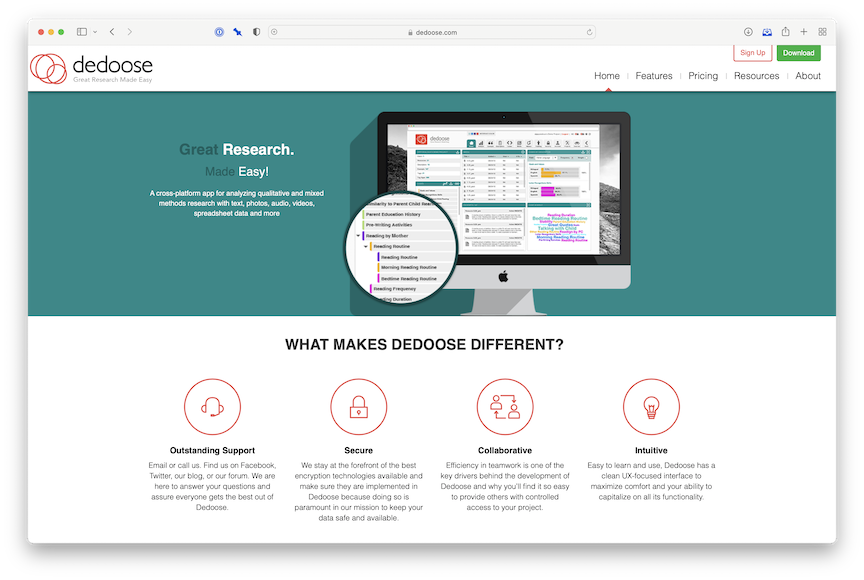 Dedoose is an alternative to other qualitative data analysis software, explicitly aimed at facilitating rigorous mixed methods research. It comes from a more academic background but is not limited to pure research as it is used in medical, market research and social policy research.
Dedoose is an alternative to other qualitative data analysis software, explicitly aimed at facilitating rigorous mixed methods research. It comes from a more academic background but is not limited to pure research as it is used in medical, market research and social policy research.
The most recent release is Version 9 which includes:
- User interface upgrade
- New language options for the user interface
- Bug fixes and performance enhancements
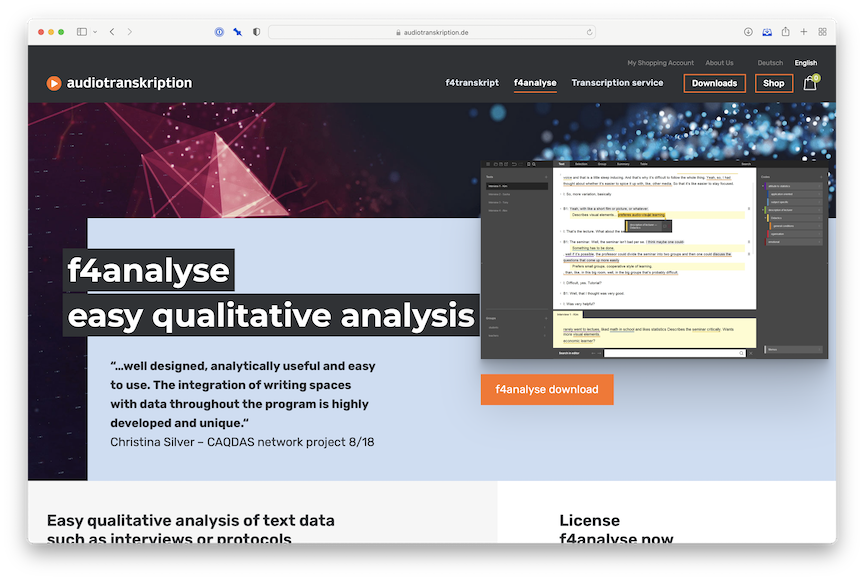 f4analyse has been designed as a low/no-code tool for data analysis and allows users to use analytic methods that do not rely on coding. It also includes the ability to take notes/memos and communicate interpretations/summaries.
f4analyse has been designed as a low/no-code tool for data analysis and allows users to use analytic methods that do not rely on coding. It also includes the ability to take notes/memos and communicate interpretations/summaries.
The most recent version is version 3.4.1 which includes:
- Text-based analysis
- Memos & comments
- Coding system
- Collaboration features
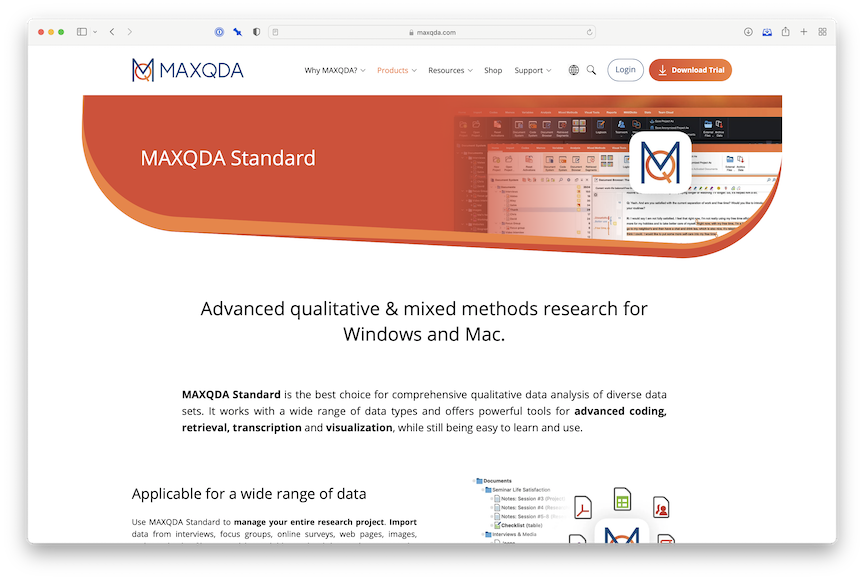 MAXQDA is designed for use in qualitative, quantitative and mixed methods research. This research focussed tool is particularly well suited to processing interviews and combining qualitative and quantitive attributes.
MAXQDA is designed for use in qualitative, quantitative and mixed methods research. This research focussed tool is particularly well suited to processing interviews and combining qualitative and quantitive attributes.
The most recent version is MAXQDA 2022 that includes a suite of text analysis tools including:
- A Profile Comparison Chart
- Word Explorer
- Import of text highlighting and comments from Word & PDF
- Code & Document Summaries
- Emojis!
- Code name suggestions
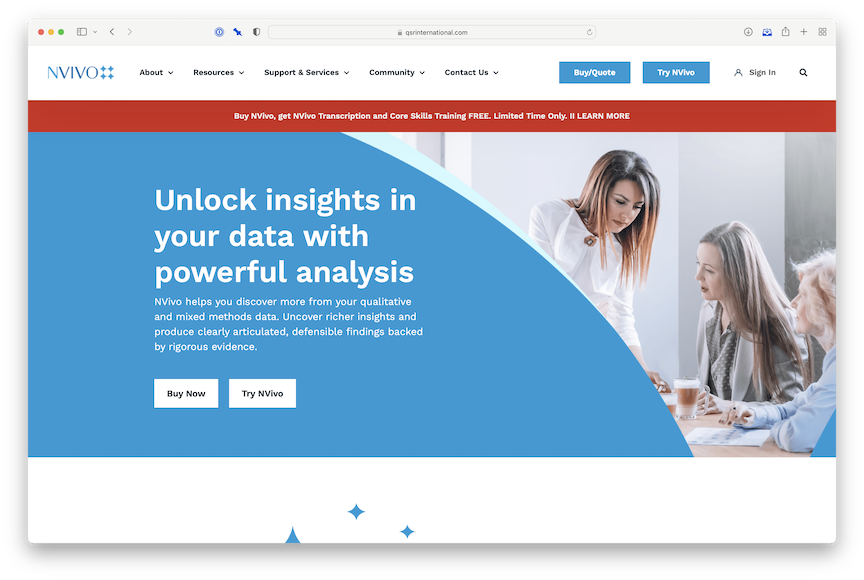 NVivo is one of the best-known desktop tools in the text analysis for the education field and is designed to organise, analyse and find insights in unstructured or qualitative data like interviews, open-ended survey responses, journal articles, social media and web content.
NVivo is one of the best-known desktop tools in the text analysis for the education field and is designed to organise, analyse and find insights in unstructured or qualitative data like interviews, open-ended survey responses, journal articles, social media and web content.
It is used ina. wide range of fields beyond education, including social sciences such as anthropology, psychology, communication, sociology, as well as fields such as forensics, tourism, criminology and marketing.
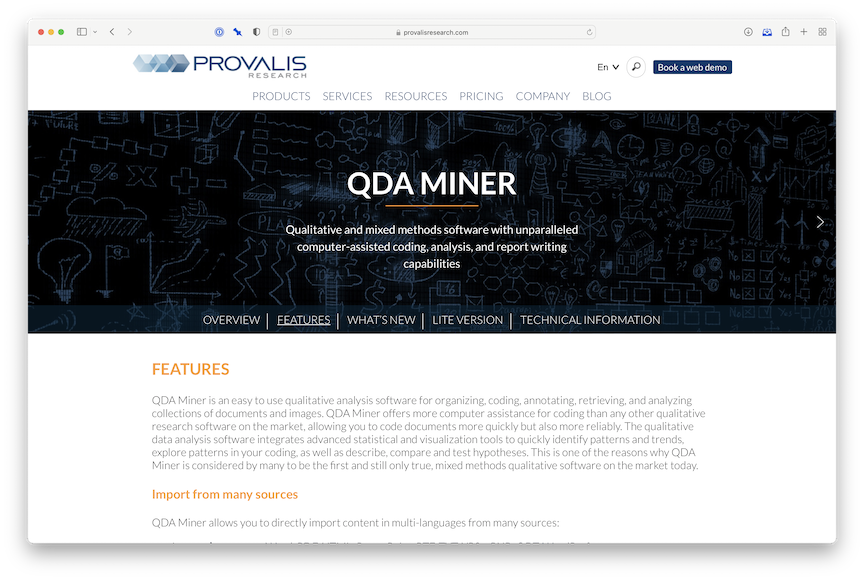 QDA Miner is another mixed methods and qualitative data analysis software package designed to assist researchers in managing, coding and analyzing qualitative data.
QDA Miner is another mixed methods and qualitative data analysis software package designed to assist researchers in managing, coding and analyzing qualitative data.
The data typically used with this qualitative research software comes from (among others), journal articles, script from TV or radio news, social media (such as Facebook, Twitter or reviews from websites), interviews or focus group transcripts and open-ended questions from surveys.
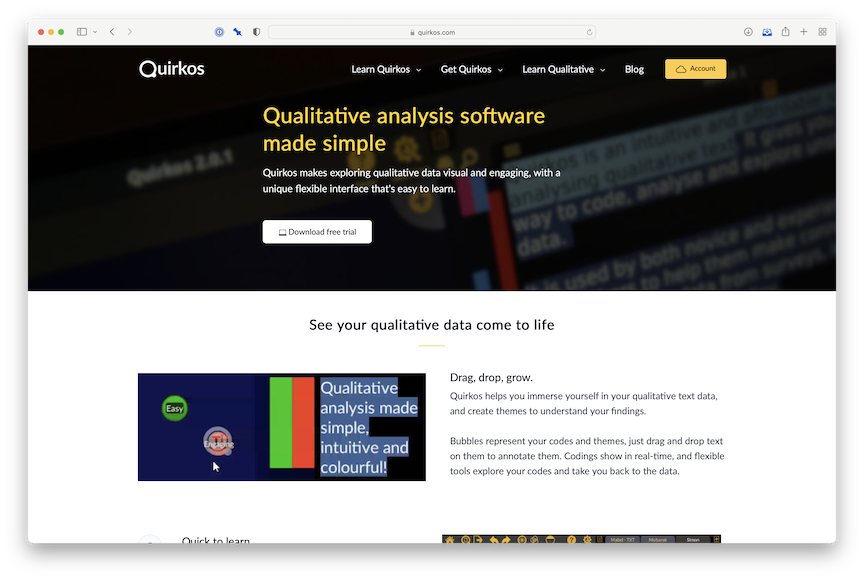 Quirkos is a CAQDAS (computer-assisted qualitative data analysis software) software package for the qualitative analysis of text data, commonly used in social science. It provides an easy to use interface designed primarily for new and non-academic users of qualitative data.
Quirkos is a CAQDAS (computer-assisted qualitative data analysis software) software package for the qualitative analysis of text data, commonly used in social science. It provides an easy to use interface designed primarily for new and non-academic users of qualitative data.
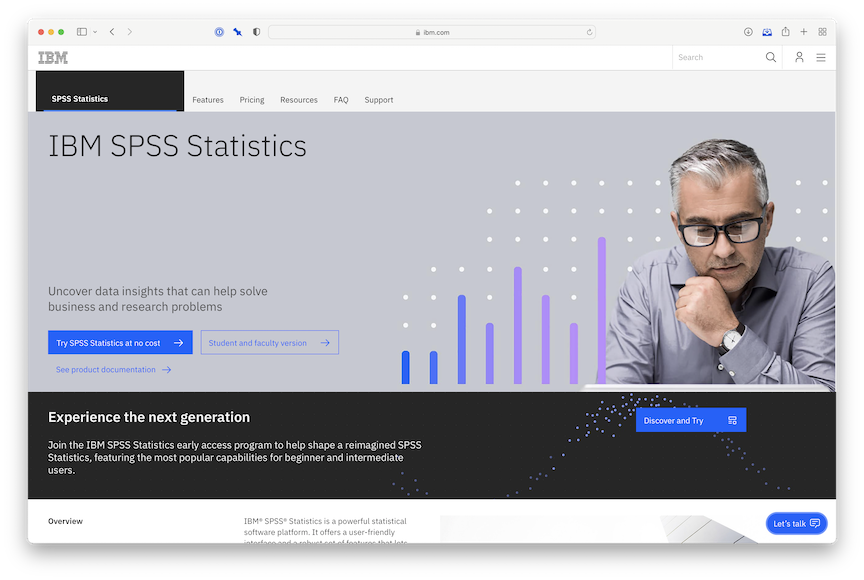 SPSS is a widely used program for statistical analysis in social science. It is also used by market researchers, health researchers, survey companies, government, education researchers, marketing organizations, data miners, and others. This is one of the classic tools in social science research but it does come with a relatively steep learning curve.
SPSS is a widely used program for statistical analysis in social science. It is also used by market researchers, health researchers, survey companies, government, education researchers, marketing organizations, data miners, and others. This is one of the classic tools in social science research but it does come with a relatively steep learning curve.
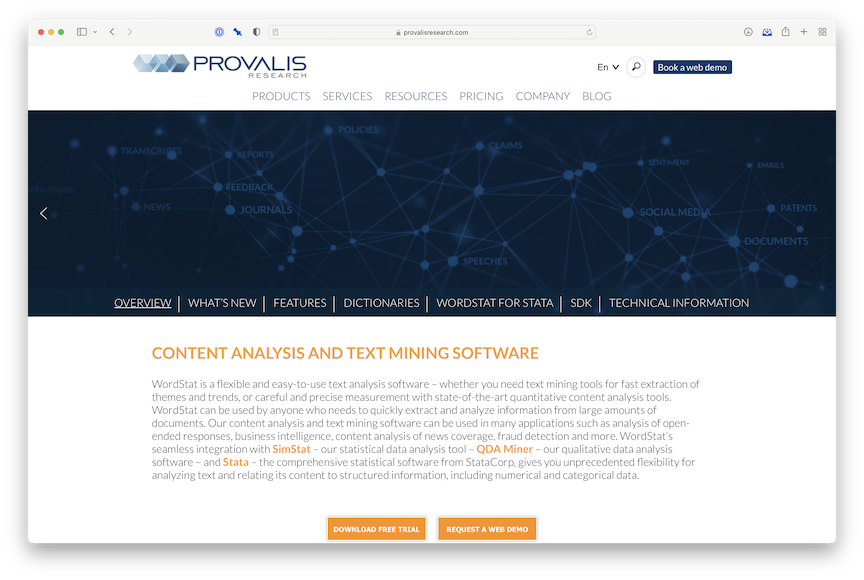 WordStat is a content analysis and text mining software. The software is mainly used for business intelligence and competitive analysis of websites, sentiment analysis, content analysis of open-ended questions, theme extraction from social media data, etc.
WordStat is a content analysis and text mining software. The software is mainly used for business intelligence and competitive analysis of websites, sentiment analysis, content analysis of open-ended questions, theme extraction from social media data, etc.
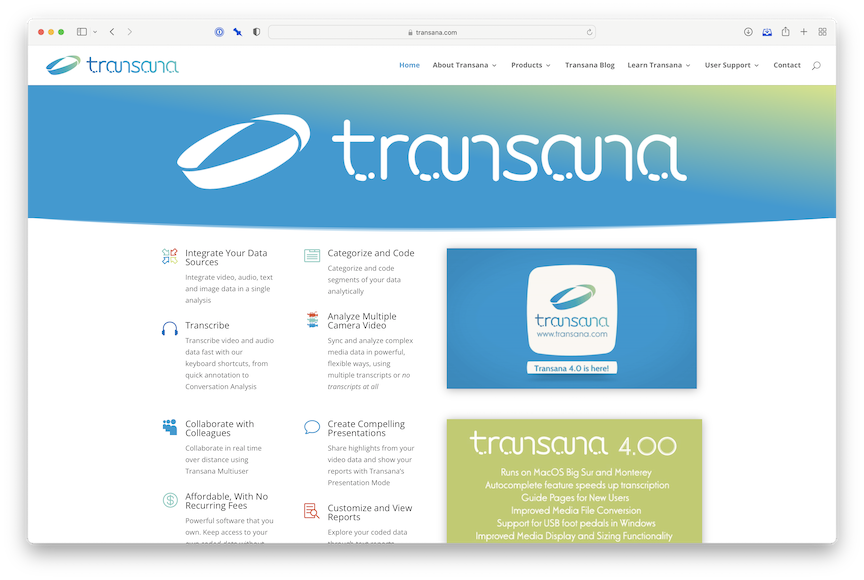 Transana is another, more general desktop tool that lets users work with video, audio, image, text and survey data. It offers audio transcription tools, video analysis as well as presentation/collaboration tools.
Transana is another, more general desktop tool that lets users work with video, audio, image, text and survey data. It offers audio transcription tools, video analysis as well as presentation/collaboration tools.
Cloud Based Software
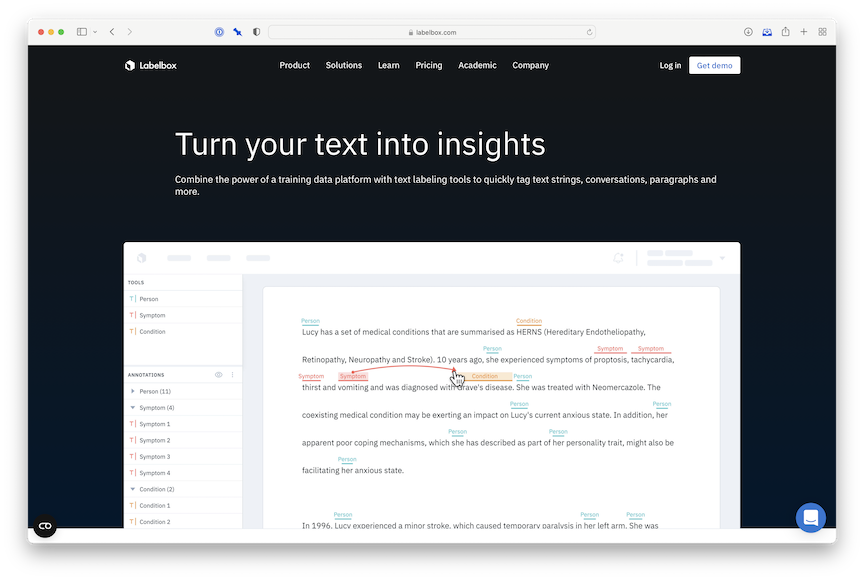 Labelbox is a training data platform for industrial data science teams for labelling and management of neural network training. Labelbox aims to develop high-quality labelled training data in order to reduce machine learning development cycles.
Labelbox is a training data platform for industrial data science teams for labelling and management of neural network training. Labelbox aims to develop high-quality labelled training data in order to reduce machine learning development cycles.
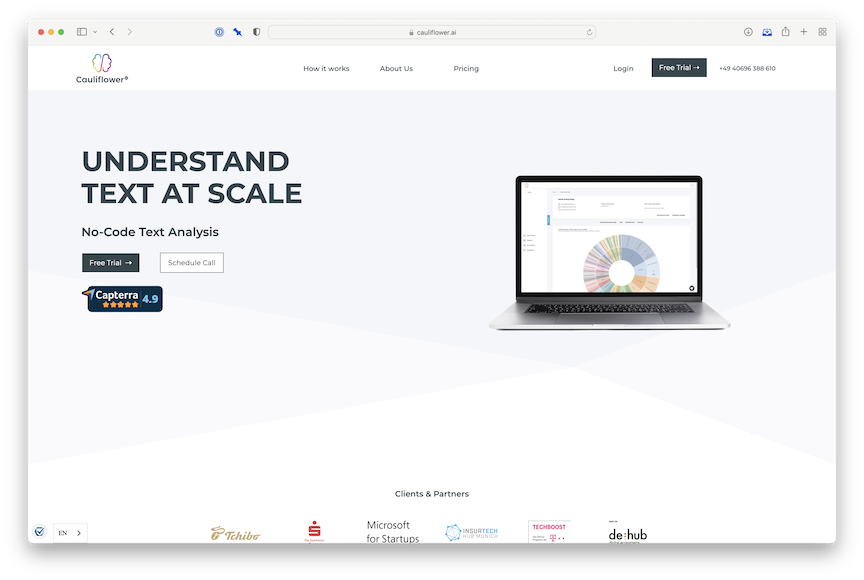 Cauliflower is an AI platform that allows you to analyze texts or verbatims and save hours of manual work. Cauliflower is used to classify open-ended questions, chats, comments and reviews. Features include topic extraction, sentiment analysis, engaging visualizations and excel export.
Cauliflower is an AI platform that allows you to analyze texts or verbatims and save hours of manual work. Cauliflower is used to classify open-ended questions, chats, comments and reviews. Features include topic extraction, sentiment analysis, engaging visualizations and excel export.
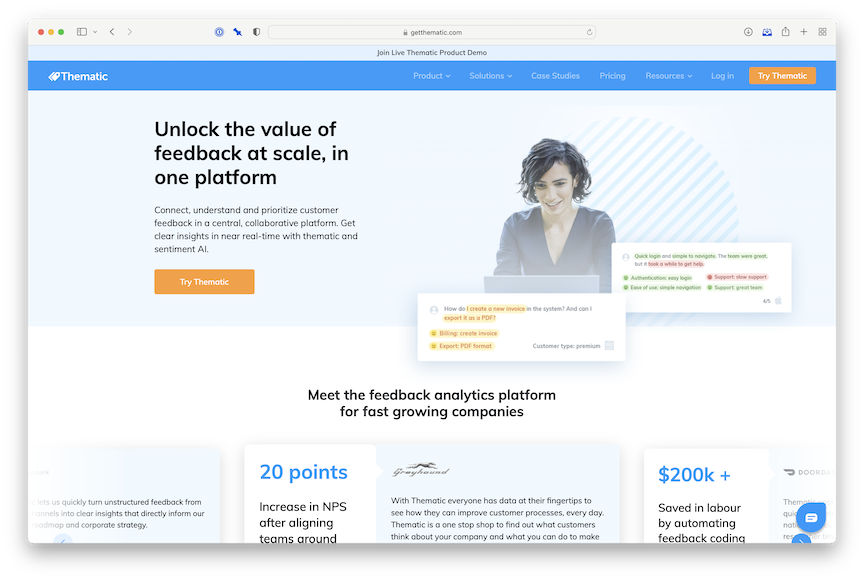 Thematic is a customer feedback analysis solution focussed on free-text comments although it could equally be used in education settings.
Thematic is a customer feedback analysis solution focussed on free-text comments although it could equally be used in education settings.
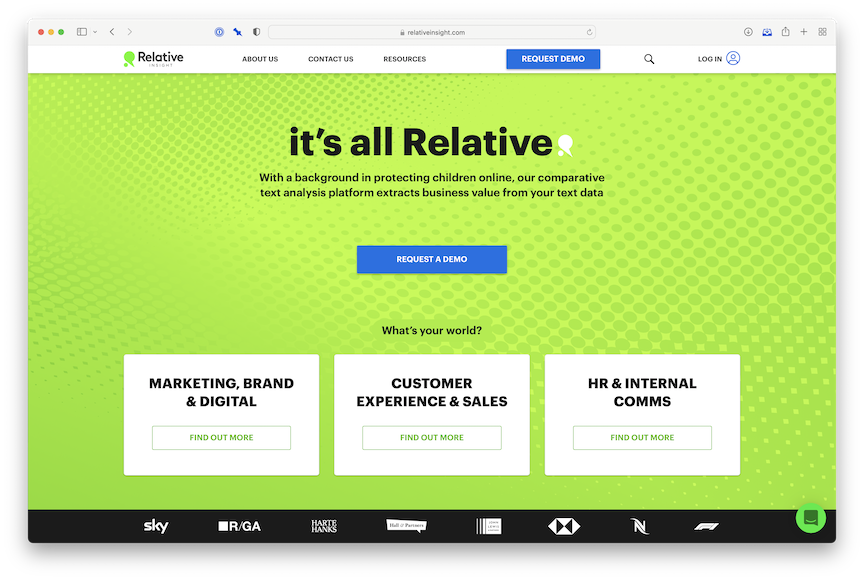 Relative Insight uses technology originally created for crime detection to detect linguistic and attitudinal differences between consumers and brands, and language differences over time. It detects statistically significant differences in words, topics, style and grammar to help brands (but also education providers) determine how to interact with consumers/students and in what context.
Relative Insight uses technology originally created for crime detection to detect linguistic and attitudinal differences between consumers and brands, and language differences over time. It detects statistically significant differences in words, topics, style and grammar to help brands (but also education providers) determine how to interact with consumers/students and in what context.
FAQ
Q: How do these text analysis software packages specifically support Student Voice initiatives?
A: Text analysis software helps in amplifying student voice initiatives by providing educators and institutions with the tools to efficiently analyse feedback, opinions, and concerns expressed by students in various formats, such as surveys, social media comments, and interviews. By using these software tools, educators can uncover trends, sentiments, and specific issues students face, thereby making informed decisions to enhance the educational experience. These analyses enable a deeper understanding of student needs, promoting a more student-centred approach to learning and institution management.
Q: What are the specific features of these software tools that make them suitable for educational contexts?
A: Features that make these software tools suitable for educational contexts include sentiment analysis, which helps in understanding the emotional tone behind student feedback; thematic analysis for identifying common topics or concerns among students; and coding capabilities that allow researchers to categorise and systematically analyse qualitative data from student interactions. These features facilitate the examination of open-ended responses and narratives, making it easier for educational institutions to gather actionable insights from student feedback.
Q: How do these tools handle data privacy and security, especially when dealing with sensitive student information?
A: These tools typically employ various data privacy and security measures to protect sensitive student information. This includes encryption of data both in transit and at rest, access controls to ensure only authorised personnel can view or process the data, and compliance with international data protection regulations such as GDPR. However, specific privacy features and security protocols can vary from one software to another, so it's important for educational institutions to review these aspects closely before choosing a tool for student voice and text analysis projects.
Q: What are the comparative costs and licensing options for educational institutions?
A: The costs and licensing options for these text analysis software tools vary widely, ranging from free or low-cost academic licenses to more expensive commercial licenses designed for large-scale use. Some tools offer special pricing for educational institutions, including discounts or customised plans based on the institution's size and specific needs. To determine the most cost-effective solution, institutions should compare the pricing structures and features of different software, considering both their immediate needs and potential for scalability.
Q: Are there any case studies or success stories of educational institutions using these tools for Student Voice projects?
A: Many educational institutions worldwide have successfully used text analysis software to enhance student voice initiatives. These projects often involve analysing feedback from course evaluations, student surveys, and online forums to improve teaching methods, curriculum design, and student services. Success stories typically highlight improvements in student satisfaction, engagement, and academic performance as a result of insights gained from text analysis. Interested educators and administrators can usually find case studies on the websites of the software providers or by contacting them directly for examples of how their tools have been applied in educational settings.
Related Entries